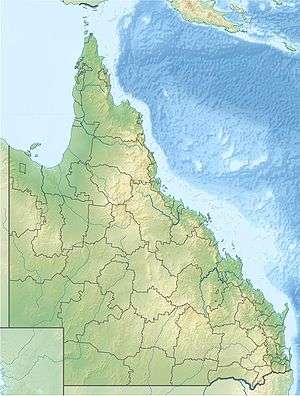Enoggera Magazine Complex
Enoggera Magazine Complex is a heritage-listed military installation at Inwood Road, Gallipoli Barracks, Enoggera, Brisbane, Queensland, Australia. It was added to the Australian Commonwealth Heritage List on 22 June 2004.[1]
| Enoggera Magazine Complex | |
|---|---|
 Location of Enoggera Magazine Complex in Queensland | |
| Location | Inwood Road, Gallipoli Barracks, Enoggera, Brisbane, Queensland, Australia |
| Coordinates | 27.4341°S 152.9779°E |
| Official name: Enoggera Magazine Complex | |
| Type | Listed place (Historic) |
| Designated | 22 June 2004 |
| Reference no. | 105229 |
The Enoggera Magazine Complex is important for its long-term and continuous association with the Enoggera Army Camp (since 1911), presently known as Gallipoli Barracks. The magazine complex displays a strong ingenuity of design and construction adapted to the Queensland climate and safety requirements related to the storage of explosive materials. Furthermore, it may be the oldest surviving post-Federation military magazine complex in Australia.[1]
Heritage listing
The Enoggera Magazine Complex, constructed between 1911 and 1915, is significant for its service as an explosives and munitions storage area for the Commonwealth defence forces, through two World Wars and numerous other conflicts until the present.[1]
Enoggera Magazine Complex was listed on the Australian Commonwealth Heritage List on 22 June 2004 having satisfied the following criteria.[1]
Criterion A: Processes
The Enoggera Magazine Complex, constructed between 1911 and 1915, is significant for its service as an explosives and munitions storage area for the Commonwealth defence forces, through two World Wars and numerous other conflicts until the present. It is an integral component of the history of the Gallipoli Barracks, formerly Enoggera Army Base, which was Queensland's major military training base for much of the twentieth century. The magazine complex, including the landscape, the cordite stores, the munitions stores (K33-37) and the explosives laboratory (K12), forms a complete and highly intact example of explosives storage methods from 1911.[1]
The magazine complex is a good example of Pye's work and an important historic example of military construction undertaken by the State at the behest of the Commonwealth in the early post-Federation period.[1]
Criterion B: Rarity
The complex is possibly the oldest continuously used explosives storage area to have been constructed for the unified Commonwealth defence forces after Federation, reflecting the development of a Commonwealth munitions production capability in the years before World War One. K16 and K18 are probably also the oldest surviving, purpose-built, military cordite storage facilities in Australia.[1]
The integrity and authenticity of these designs is enhanced by the continuity of function and lack of active development of the buildings or their setting since 1911.[1]
Criterion D: Characteristic values
The Enoggera Magazine Complex displays clear design elements relative to its function of storing highly dangerous explosives. The location of the complex in an isolated pocket of the army base, the building of the magazines into the side of existing ridges and rises, and the safety distances between structures are a key feature of the landscape design.[1]
Criterion F: Technical achievement
The buildings themselves illustrate specific solutions to the functional and safety requirements of the site, including surrounding reinforced concrete berms, cavity brick construction, gritless asphalt floors, as well as a astute ventilation design, featuring wrap-around verandas, double roofing and ventilators along the length of the roofs.[1]
Criterion H: Significant people
The complex is strongly associated with the architectural career of Thomas Pye. Pye effected the designs whilst Deputy Government Architect with the Queensland Public Works Department. Along with AB Brady and JS Murdoch, Pye was part of a prolific period of public works in Queensland between 1890 and 1920, to designs by the Queensland Government Architect's office on behalf of the State and the new Commonwealth.[1]
References
- "Enoggera Magazine Complex (Place ID 105229)". Australian Heritage Database. Department of the Environment. Retrieved 15 May 2019.
Bibliography
- Interiors Australia Pty Ltd, 1995. Gallipoli Barracks Magazine Complex: conservation plan.
- First Military District Historic Buildings Committee, 1981. Report - Historic Buildings - Enoggera Military Complex.
- Queensland Heritage Register. Citation 600192.
- Watson, D and J McKay. 1994. Queensland Architects of the 19th Century. Brisbane, Queensland Museum.
- Register of the National Estate database.
Attribution
![]()